ear health
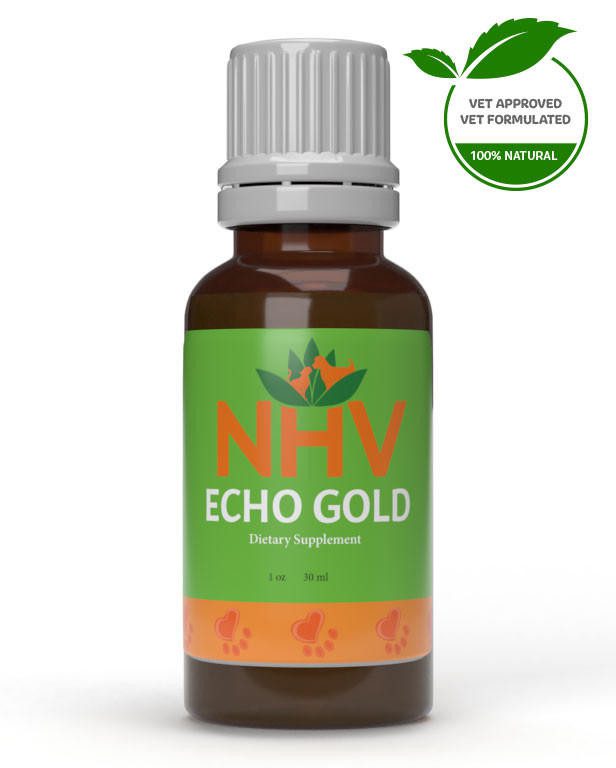
free shipping over $100 (USA & Canada)
1-877-937-4372 the pet expert hotline
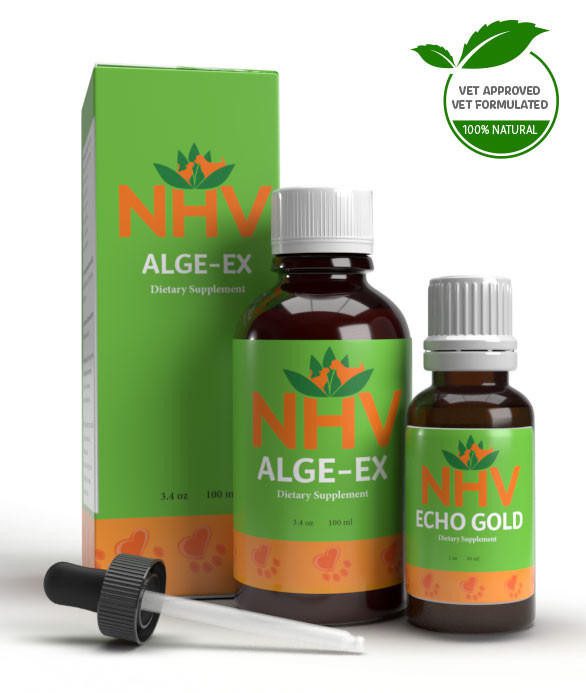
Keeping your dog’s ears clean is an important part of their overall health. Learning how to correctly clean dog ears can help prevent infections and other problems. This guide will walk you through dog ear anatomy, signs of infection, and how to clean your dog’s ears safely.
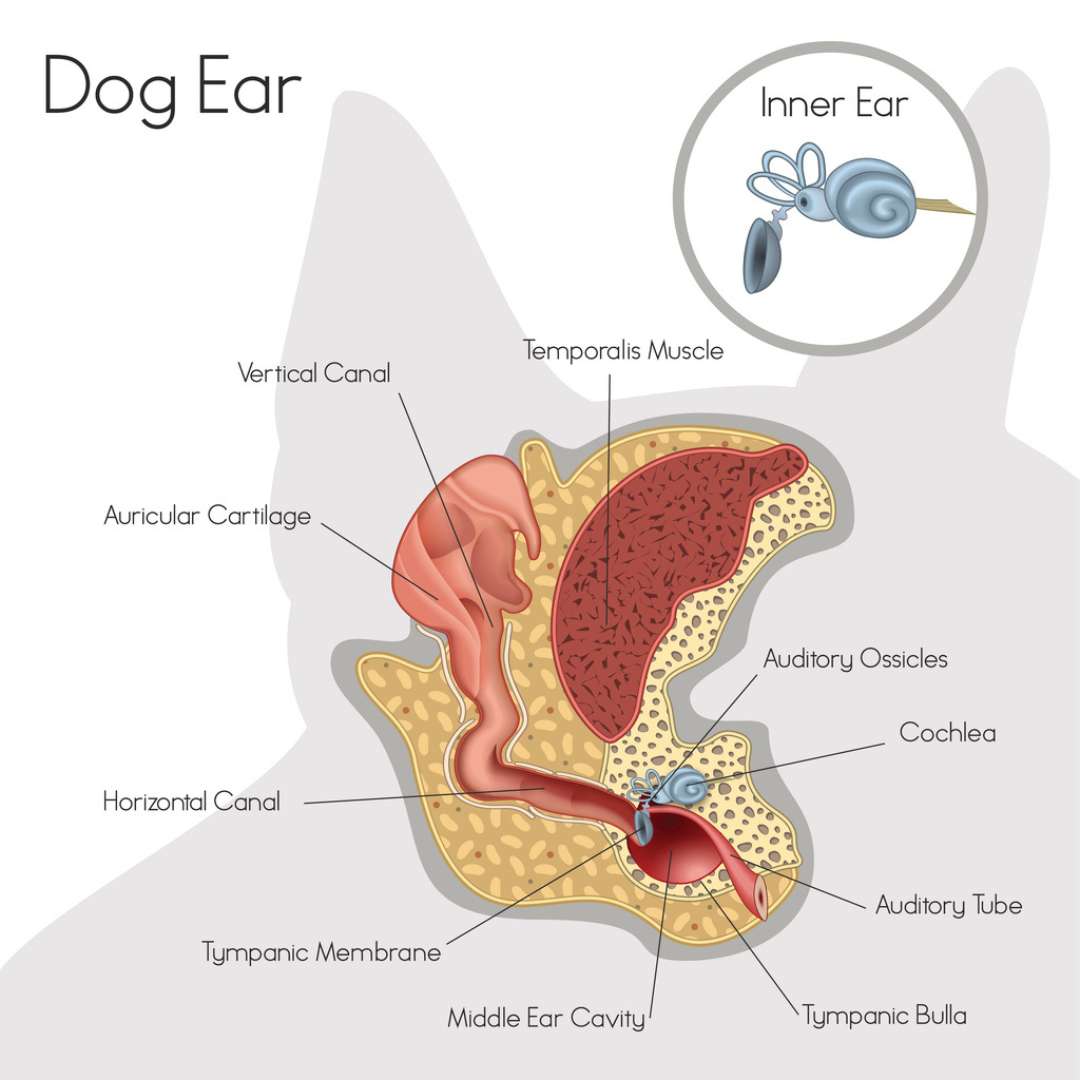
The anatomy of your furbaby ear matters, pups with floppy ears are more likely to have chronic ear problems than their counterparts with pointy, erect ears.
Dogs with floppy ears are prone to chronic ear problems compared to those with pointy, erect ears due to differences in ear anatomy.
To obtain a better understanding of the ear, let’s break down the anatomy of the organ. The ear consists of three components, the outer, middle, and inner ear. The outer ear includes the pinna (the part you see that is made of cartilage and covered by skin, fur, or hair) and the ear canal. The size and shape of the pinna can vary by breed and can result in different requirements for grooming and maintenance.
The middle ear starts with the eardrum and includes three tiny bones (hammer, anvil, stirrup), two muscles (oval window, eustachian tube), and a small air-filled chamber. Its structure amplifies sound and links to the back of the nose, allowing pressure equalization. Keeping this area clean and dry is crucial for sound transmission and our auditory system.
The inner ear is a highly complex structure. This part includes: the cochlea, responsible for hearing; the vestibular system, the organ of balance. The nerve endings within the inner ear are responsible for transmitting vibrations to electrical impulses, which allows the brain to interpret these impulses so we can hear! The vestibular system comprises three fluid-filled loops that detect head rotation and body position. This system is what allows rapid movements and response to our external environment. It’s common to notice slight changes in your pet’s gait as they age. However, it’s essential to inform your vet about these changes to rule out any underlying issues.
Infections of the ear are common in dogs and, in most cases, can be remedied with regular cleanings. Always monitor the ear for signs of inflammation (redness, warmth, or swelling), injury, secretions, odor, or excessive ear wax. Routine maintenance is always easier than treatment.
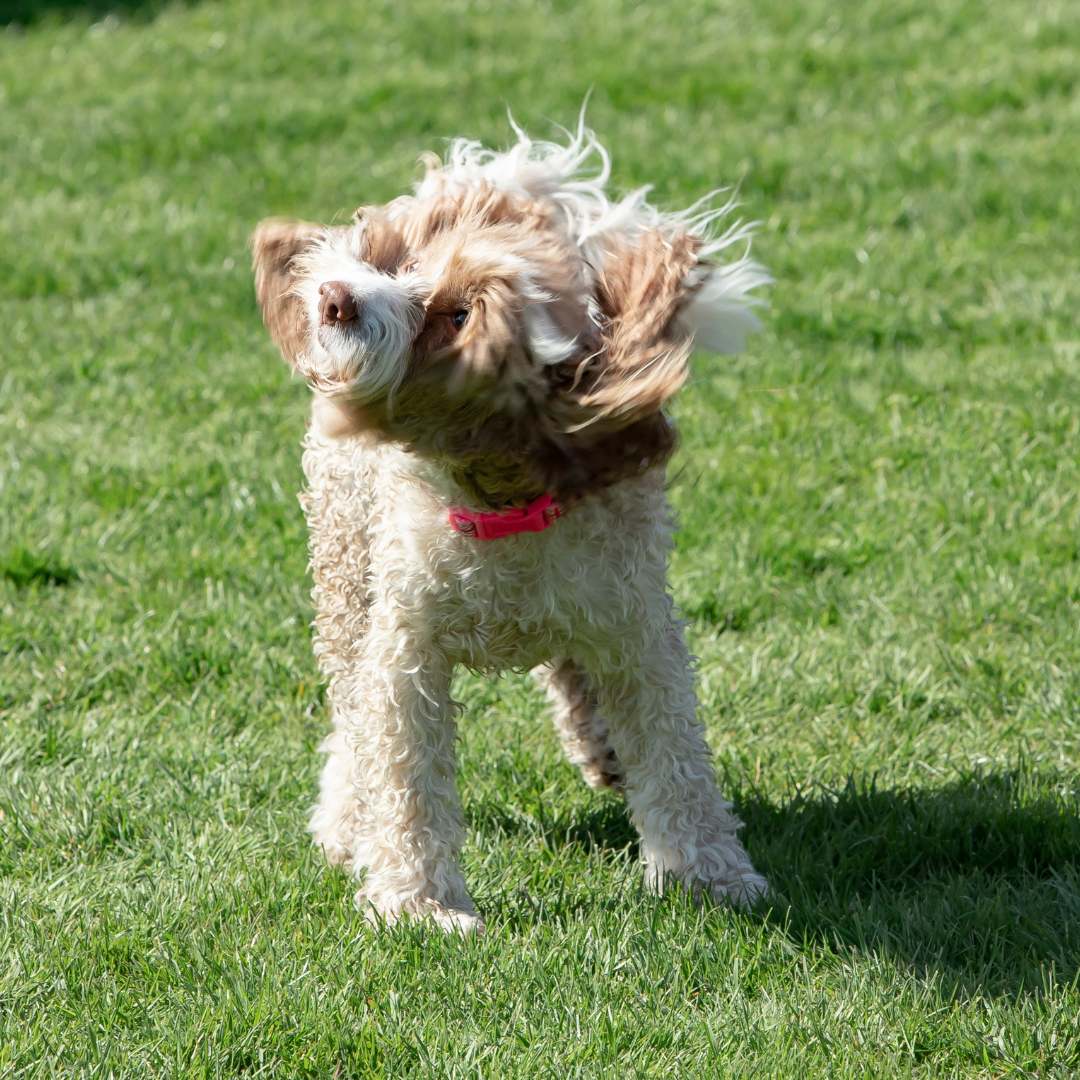
Additionally, when your pup is experiencing hearing loss, scratching, head shaking, dizziness, or loss of balance, this can often be due to build-up, inflammation, or infection within any of these areas. Prompt action and attention is a key component to a speedy recovery.
Always monitor the ear for signs of inflammation (redness, warmth, or swelling), injury, secretions, odor, or excessive ear wax.
Before taking on the task of cleaning dog ears you should have all your supplies set up and ready. Laying everything out on a flat surface, with lids off, is a great place to start.
A good quality ear cleaner is essential, solutions like hydrogen peroxide and alcohol can be very irritating and cause more harm than good, especially if there is already present inflammation. Some cleaners have antibacterial and antifungal properties or are simply more efficient at removing wax build-up. It is best to speak with your vet or groomer about what type of cleaner is best suited for your pup’s unique ear composition.
Gauze pads are the preferred type of tool to use. It is because their fibers don’t break off as easily as cotton balls, reducing the risk of fibers being left behind after cleaning. Do not use cotton swabs or pointy objects when attempting to clean the ear. This is a major risk for causing more injury or trauma to the eardrum and ear canal.
1. Stabilize your pup and have them calm and under control.
2. While holding the head steady, lift the pinna up vertically to expose the ear canal. Visually inspect for signs of inflammation or excessive build-up. If no concerning signs, proceed with squeezing in some of the ear-cleaning solutions to fill the ear canal.
3. While still holding the pinna, gently massage the external base of the ear and around the middle ear to work in the cleaner. Working from the inside out, begin wiping with the gauze pad from the inner ear toward the outer pinna. Do not ever go back into the ear canal with a previously used gauze pad! Use a new one each time.
4. Once most of the solution is out, let your pup shake their head. Check the inner ear again and wipe out any new presenting debris. Only go into the ear canal as far as your finger can reach. Use as many pads as necessary until it comes out clean after wiping.
5. Once the ear canal is dry, using a moisturizing agent like Echo Gold can be added to the inner ear, similarly to the cleaner. Add a few drops and massage the base of the ear. If needed, you may use a gauze pad further to apply the echo gold toward the outer pinna. The naturally viscous and moisturizing formula will create a seal to soothe the skin and provide herbal benefits.
6. Repeat with the next ear. Don’t forget lots of praise and treats can go a long way.
It is important to keep the auditory canal clean of dirt and hair. It is common to have hair growing inside the ear, to have this removed, it is best to be done by a professional to avoid trauma or injury.
Ears should be cleaned every 3-4 weeks, in cases with recurring infections, it is best to follow your vet’s advice on cleaning frequency. Once-a-week ear checks can be highly beneficial and save you a trip to the vet.
If your pet is a wiggle worm or doesn’t like to have their ears cleaned we recommend having a partner with you when cleaning. This will not only make the process faster and more efficient but safer for your beloved companion.
It is helpful to sit behind your pup with them between your legs. If they are larger, you may need to stand and straddle over them to the right angle for cleaning. Or you can lay them down between your legs.
If you have a partner, have them “hug” your pup around the chest and under the stomach by the hind legs. This will keep the head free and mobile but the body still.
Congratulations you have successfully cleaned your pup’s ear safely!
It is highly important to maintain the ears and manage any signs of inflammation or infection by speaking with your vet. After diagnosis or further understanding of the underlying cause we are able to better tackle and treat their condition. Here are some NHV supplements that can support stars in your companion’s ear health:
NHV Echo Gold -is an herbal formula with anti-inflammatory and antibiotic activity for topical use to help pets recover quickly from ear infections and alleviate the irritating symptoms associated with them. Ear infections are a common condition caused by allergies, wax buildup, water, or small bodies in the ear, such as ear mites.
NHV Stimmune– is an herbal formula that promotes healthy immune activity and histamine response when the underlying cause is internal or diet-related. Stimmune can help with symptoms like hot spots, itchy ears, face rubbing and allergic dermatitis.
NHV Alge-Ex – targets environmental allergies, fungal and airborne irritants, offers histamine response and may support symptoms such as ear infection, yeast infection, sneezing, itchy, and eye rubbing.
NHV PetOmega 3 – improves the skin’s barriers and reduces inflammation, which will help inhibit infections from forming.
Unsure about the best supplements for your pets? Don’t hesitate to reach out! Our Pet Experts at NHV are here to help.
ear health

Holistic Ear Drops for Dogs
buy 2 and save $3
Has your pup been shaking his/her head a lot? This could be caused by dog ear infection! NHV Echo Gold is a vet-formulated ear drops for dogs. It is designed to help ease discomfort and inflammation caused by dog ear mites, allergens, insect bites, parasitic mites, fungal/bacterial dog ear infection, and more. 100% natural and topical use only.


Has your pup been shaking his/her head a lot? This could be caused by dog ear infection! NHV Echo Gold is a vet-formulated ear drops for dogs. It is designed to help ease discomfort and inflammation caused by dog ear mites, allergens, insect bites, parasitic mites, fungal/bacterial dog ear infection, and more. 100% natural and topical use only.

Seeing our precious little ones suffering from dog ear infection is not easy. However, this condition is extremely common in dogs, which begs the question - how can we help support them? The herbal ear drops for dogs, Echo Gold, can help with ear infection symptoms and healing.
Please note that this supplement can only be used topically. Warm the formula by placing the bottle in hot water or running it under hot water for 30 seconds. Shake well, then drop a few drops into the dog’s ear canal. By using a cotton swab, apply the extract to the outer ear area as well. Use twice daily to help with dog ear infection. For proactive support and regular maintenance, use as much as you need.
Exterior ear canal infection is the most common ear condition in dogs. It causes excessive ear discharge, unpleasant odor, ear inflammation, and more. You may also notice your pup shaking, scratching and rubbing their head frequently due to pain and itchiness. Echo Gold for Dogs can help address these uncomfortable symptoms.
This herbal formula possesses anti-inflammatory and antibiotic properties. The blend of herbs - chamomile, Goldenseal, Echinacea angustifolia, Myrrh, and tea tree oil - helps support your furkid’s ear condition in different ways.
Herbs like Echinacea angustifolia, Myrrh, and Tea tree oil are traditionally used to manage infections. Their anti-microbial and antiseptic properties help control and inhibit bacterial formation. Tea tree oil can even help eliminate bad odors caused by ear infections.
Goldenseal and Chamomile can help soothe and heal inflamed and irritated ears. The analgesic ability of Chamomile can even help with the discomfort dog ear infection may cause.
Our Canadian-made products have supported thousands of pets worldwide! Read NHV reviews and how they’ve helped other furmilies. They are human-grade quality products made in a GMP-certified, FDA-approved facility. Your furkiddo’s health and safety are our top priorities!
Ear infections could be a complication of an underlying disease. It is vital to pinpoint the root cause in order to cure your pup.
All our products are 100% natural herbal supplements formulated by a holistic veterinarian and master herbalist with over 50+ years of experience.
We have a team of supportive Pet Experts to help you and your furkiddos with any questions and concerns! So, please don’t hesitate to reach out if you need anything! We are always here to help.
Help protect your dog from ear infections by ordering our Echo Gold for dogs!
For more information about ear infections in dogs and our Echo Drop, click to watch our video about Ear Infection Support For Cats & Dogs here. Or read our blog post on on how to prevent ear infections in cats and dogs.
In addition to herbal supplements like ear drops for dogs, regular ear cleaning is vital for recovery. Watch our YouTube videos on tips for cleaning Your pet's ears and ways to clean your little one’s ears.
All NHV supplements are made with the finest quality organic or ethically harvested herbs. We use non-GMO vegetable glycerin as our base. NHV products are full-spectrum extracts.
Topical Use Only: Warm the ECHO GOLD by placing the bottle in hot water or running under hot water for 30 seconds. Shake well. Place a few drops in to the ear canal. Using a cotton swab apply to outer ear area as well.
Information presented by NHV Natural Pet Products is for educational purposes only.
Seeing our precious little ones suffering from dog ear infection is not easy. However, this condition is extremely common in dogs, which begs the question - how can we help support them? The herbal ear drops for dogs, Echo Gold, can help with ear infection symptoms and healing.
Please note that this supplement can only be used topically. Warm the formula by placing the bottle in hot water or running it under hot water for 30 seconds. Shake well, then drop a few drops into the dog’s ear canal. By using a cotton swab, apply the extract to the outer ear area as well. Use twice daily to help with dog ear infection. For proactive support and regular maintenance, use as much as you need.
Exterior ear canal infection is the most common ear condition in dogs. It causes excessive ear discharge, unpleasant odor, ear inflammation, and more. You may also notice your pup shaking, scratching and rubbing their head frequently due to pain and itchiness. Echo Gold for Dogs can help address these uncomfortable symptoms.
This herbal formula possesses anti-inflammatory and antibiotic properties. The blend of herbs - chamomile, Goldenseal, Echinacea angustifolia, Myrrh, and tea tree oil - helps support your furkid’s ear condition in different ways.
Herbs like Echinacea angustifolia, Myrrh, and Tea tree oil are traditionally used to manage infections. Their anti-microbial and antiseptic properties help control and inhibit bacterial formation. Tea tree oil can even help eliminate bad odors caused by ear infections.
Goldenseal and Chamomile can help soothe and heal inflamed and irritated ears. The analgesic ability of Chamomile can even help with the discomfort dog ear infection may cause.
Our Canadian-made products have supported thousands of pets worldwide! Read NHV reviews and how they’ve helped other furmilies. They are human-grade quality products made in a GMP-certified, FDA-approved facility. Your furkiddo’s health and safety are our top priorities!
Ear infections could be a complication of an underlying disease. It is vital to pinpoint the root cause in order to cure your pup.
All our products are 100% natural herbal supplements formulated by a holistic veterinarian and master herbalist with over 50+ years of experience.
We have a team of supportive Pet Experts to help you and your furkiddos with any questions and concerns! So, please don’t hesitate to reach out if you need anything! We are always here to help.
Help protect your dog from ear infections by ordering our Echo Gold for dogs!
For more information about ear infections in dogs and our Echo Drop, click to watch our video about Ear Infection Support For Cats & Dogs here. Or read our blog post on on how to prevent ear infections in cats and dogs.
In addition to herbal supplements like ear drops for dogs, regular ear cleaning is vital for recovery. Watch our YouTube videos on tips for cleaning Your pet's ears and ways to clean your little one’s ears.
All NHV supplements are made with the finest quality organic or ethically harvested herbs. We use non-GMO vegetable glycerin as our base. NHV products are full-spectrum extracts.
Topical Use Only: Warm the ECHO GOLD by placing the bottle in hot water or running under hot water for 30 seconds. Shake well. Place a few drops in to the ear canal. Using a cotton swab apply to outer ear area as well.
Information presented by NHV Natural Pet Products is for educational purposes only.
allergy support
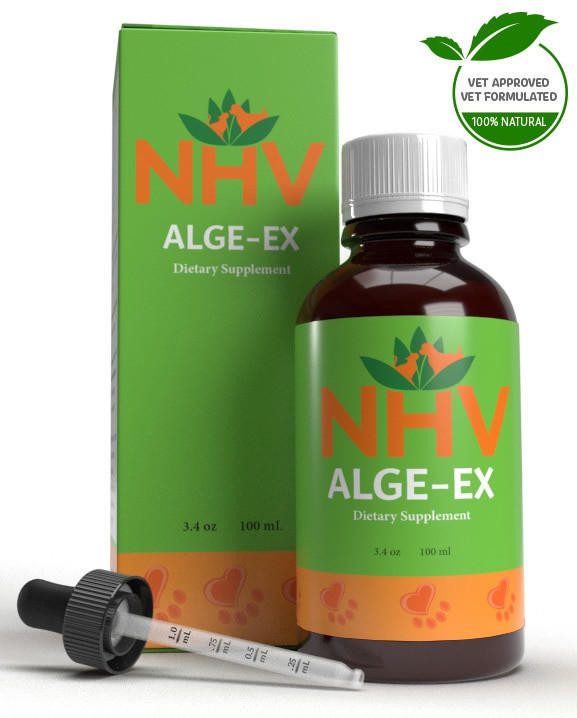
Natural Remedy for Environmental Allergies in Dogs
buy 2 and save $3
3 month supply for a small to medium size pet.
Achoo - oh no, is your sweet pup suffering from environmental allergies in dogs? NHV Alge-Ex for Dogs can help support your furkid with environmental allergies and help ease symptoms. The 100% herbal formula can also serve as proactive support for potential allergic reactions.

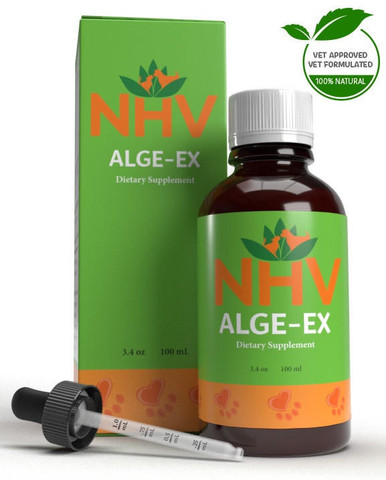
Achoo - oh no, is your sweet pup suffering from environmental allergies in dogs? NHV Alge-Ex for Dogs can help support your furkid with environmental allergies and help ease symptoms. The 100% herbal formula can also serve as proactive support for potential allergic reactions.

Seeing our precious pups struggle with allergies in dogs is rough. However, environmental allergens are unavoidable. From dust at home to different pollens and pests in nature, it is very easy for our outdoorsy pups to get in contact with these potential triggers.
You may ask, “Is there a natural way to help support them?”
The answer is yes!
Holistic supplements like our Alge-Ex for dogs can help support environmental allergies in dogs. The herbal blend helps manage your pup’s immune response to keep those allergic reactions at bay, helps reduce symptoms during an acute allergy attack, and helps with environmental allergy symptoms. 100% natural and free of additives and preservatives, this vet formulation contains a blend of herbs like Eyebright (an anti-inflammatory herb used to help itchy eyes and eye infections), Echinacea Angustifolia (to help with immune support), Ginger (a natural antioxidant that can support the respiratory system), and more.
We all know that preventing our furkids from inhaling or being in contact with environmental allergens is almost impossible. Fortunately, you can help support your pup’s immune reaction to these airborne irritants by using safe and natural herbal supplements like our Alge-Ex for dogs.
Alge-Ex for dogs helps prevent allergies by supporting histamine and immune response activity. Herbs like Feverfew help manage the formation of histamine. The unique blend of herbs also helps alleviate the symptoms of environmental allergies and hay fever. For example, Eyebright helps ease itchy eyes and helps with swollen eyelids and blood vessels. Echinacea, at the same time, has been used to help with sinusitis, hay fever, asthma, and ear infections.
All our products are made in Canada and have helped thousands of pets around the world! Just read some of our real stories from pets. They are human-grade and manufactured in a GMP-certified and FDA-approved facility. We can take the safety and health of your pet seriously!
Allergies in dogs happen when their immune system overreacts to a foreign substance (allergen). In environmental allergies, these allergens can be dust, pollens, grasses, weeds, molds, and many more. When your pup’s body senses the allergen, it will set off a range of allergic reactions to defend their body against them. These reactions lead to different symptoms.
If you notice these symptoms, please visit a vet for a full examination.
All our products are 100% natural herbal supplements formulated by a holistic veterinarian and master herbalist with over 50+ years of experience.
We have a team of supportive Pet Experts to help you and your furkiddos with any questions and concerns! So, please don’t hesitate to reach out if you need anything! We are always here to help.
Help protect your dog from allergies by ordering our Alge-Ex for dogs!
If you want to learn more about environmental and seasonal allergies in dogs, feel free to check out our blogs about canine allergies and how to alleviate dog allergies.
A healthy, balanced diet is also vital to their recovery and may help relieve the inflammation and irritation they experience. Our in-house veterinarian, Dr. Amanda, can help design a personalized diet plan for your sweetheart. Please reach out if you need her help!
All NHV supplements are made with the finest quality organic or ethically harvested herbs. We use non-GMO vegetable glycerin as our base. NHV products are full-spectrum extracts.
Select your pet's weight to determine the correct dose.
To be taken twice daily. Determine your pet’s weight and then use the easy chart below to determine the correct dose. This is the minimum dosage.
Pet's Weight Dosage
0 - 15 lb = 0.5 ml
16 - 30 lb = 1.0 ml
31 - 45 lb = 1.5 ml
46 - 60 lb = 2.0 ml
61 - 75 lb = 2.5 ml
Over 75 lb = 3.0 ml
How to Administer: Shake well before use. The easiest method is to use the dropper provided and place the drops into your pet’s food or favorite treat. You can also use the dropper and squirt directly into the pet’s mouth. Some pets can be finicky, if this occurs consider hiding the drops in foods most pet’s love such as fish, chicken, yogurt, or a favorite treat. If your pet only eats dry food then soak a few kibbles at feeding time.
For Best Results
Herbal dietary supplements are beneficial to the health and well-being of your pet and are safe for long-term use. Every pet responds to natural herbal supplements differently, therefore it is important to be consistent and administer the product daily. Supplements generally take two to four weeks to take effect, however this will vary from one animal to the next.
Product Storage
All NHV Natural Pet Products are pure herbal extracts and contain no artificial additives, preservatives, or coloring. Shelf life after opening is 6 months and must be refrigerated after opening.
Cautions and Contraindications
Do not use Alge-Ex in pregnant or nursing animals.
Speak to your vet before using our products. A second visit is recommended if your pet’s condition does not improve, or deteriorates after continued use of the supplements.
All information provided by NHV Natural Pet Products is for educational purposes only.
Seeing our precious pups struggle with allergies in dogs is rough. However, environmental allergens are unavoidable. From dust at home to different pollens and pests in nature, it is very easy for our outdoorsy pups to get in contact with these potential triggers.
You may ask, “Is there a natural way to help support them?”
The answer is yes!
Holistic supplements like our Alge-Ex for dogs can help support environmental allergies in dogs. The herbal blend helps manage your pup’s immune response to keep those allergic reactions at bay, helps reduce symptoms during an acute allergy attack, and helps with environmental allergy symptoms. 100% natural and free of additives and preservatives, this vet formulation contains a blend of herbs like Eyebright (an anti-inflammatory herb used to help itchy eyes and eye infections), Echinacea Angustifolia (to help with immune support), Ginger (a natural antioxidant that can support the respiratory system), and more.
We all know that preventing our furkids from inhaling or being in contact with environmental allergens is almost impossible. Fortunately, you can help support your pup’s immune reaction to these airborne irritants by using safe and natural herbal supplements like our Alge-Ex for dogs.
Alge-Ex for dogs helps prevent allergies by supporting histamine and immune response activity. Herbs like Feverfew help manage the formation of histamine. The unique blend of herbs also helps alleviate the symptoms of environmental allergies and hay fever. For example, Eyebright helps ease itchy eyes and helps with swollen eyelids and blood vessels. Echinacea, at the same time, has been used to help with sinusitis, hay fever, asthma, and ear infections.
All our products are made in Canada and have helped thousands of pets around the world! Just read some of our real stories from pets. They are human-grade and manufactured in a GMP-certified and FDA-approved facility. We can take the safety and health of your pet seriously!
Allergies in dogs happen when their immune system overreacts to a foreign substance (allergen). In environmental allergies, these allergens can be dust, pollens, grasses, weeds, molds, and many more. When your pup’s body senses the allergen, it will set off a range of allergic reactions to defend their body against them. These reactions lead to different symptoms.
If you notice these symptoms, please visit a vet for a full examination.
All our products are 100% natural herbal supplements formulated by a holistic veterinarian and master herbalist with over 50+ years of experience.
We have a team of supportive Pet Experts to help you and your furkiddos with any questions and concerns! So, please don’t hesitate to reach out if you need anything! We are always here to help.
Help protect your dog from allergies by ordering our Alge-Ex for dogs!
If you want to learn more about environmental and seasonal allergies in dogs, feel free to check out our blogs about canine allergies and how to alleviate dog allergies.
A healthy, balanced diet is also vital to their recovery and may help relieve the inflammation and irritation they experience. Our in-house veterinarian, Dr. Amanda, can help design a personalized diet plan for your sweetheart. Please reach out if you need her help!
All NHV supplements are made with the finest quality organic or ethically harvested herbs. We use non-GMO vegetable glycerin as our base. NHV products are full-spectrum extracts.
Select your pet's weight to determine the correct dose.
To be taken twice daily. Determine your pet’s weight and then use the easy chart below to determine the correct dose. This is the minimum dosage.
Pet's Weight Dosage
0 - 15 lb = 0.5 ml
16 - 30 lb = 1.0 ml
31 - 45 lb = 1.5 ml
46 - 60 lb = 2.0 ml
61 - 75 lb = 2.5 ml
Over 75 lb = 3.0 ml
How to Administer: Shake well before use. The easiest method is to use the dropper provided and place the drops into your pet’s food or favorite treat. You can also use the dropper and squirt directly into the pet’s mouth. Some pets can be finicky, if this occurs consider hiding the drops in foods most pet’s love such as fish, chicken, yogurt, or a favorite treat. If your pet only eats dry food then soak a few kibbles at feeding time.
For Best Results
Herbal dietary supplements are beneficial to the health and well-being of your pet and are safe for long-term use. Every pet responds to natural herbal supplements differently, therefore it is important to be consistent and administer the product daily. Supplements generally take two to four weeks to take effect, however this will vary from one animal to the next.
Product Storage
All NHV Natural Pet Products are pure herbal extracts and contain no artificial additives, preservatives, or coloring. Shelf life after opening is 6 months and must be refrigerated after opening.
Cautions and Contraindications
Do not use Alge-Ex in pregnant or nursing animals.
Speak to your vet before using our products. A second visit is recommended if your pet’s condition does not improve, or deteriorates after continued use of the supplements.
All information provided by NHV Natural Pet Products is for educational purposes only.
immune & allergy support
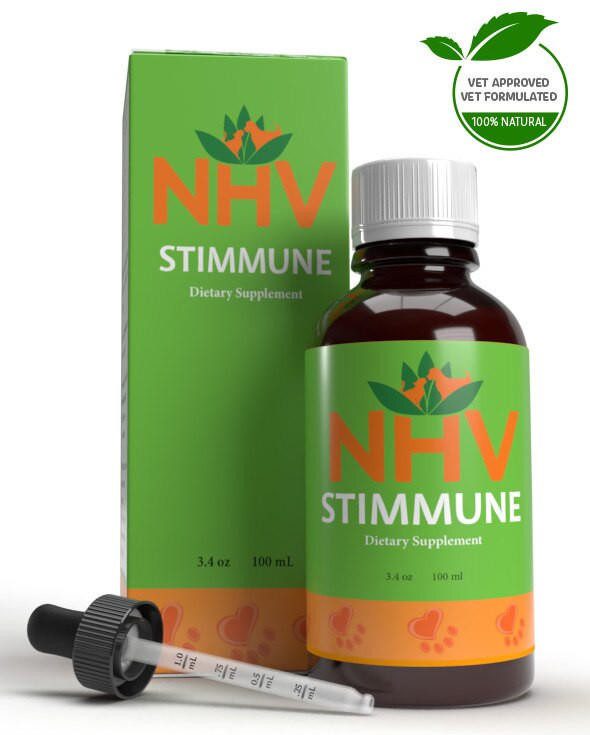
Natural Dog Food Allergy Supplement and Immune Support.
buy 2 and save $3
3 month supply for a small to medium size
Soothes food allergies, skin allergies (dermatitis), and infection. Helps relieve a variety of symptoms related to allergies. Supports a healthy balance of the immune system in pets with conditions such as autoimmune disease.

Soothes food allergies, skin allergies (dermatitis), and infection. Helps relieve a variety of symptoms related to allergies. Supports a healthy balance of the immune system in pets with conditions such as autoimmune disease.
Stimmune helps balance the immune system and helps ease allergy symptoms that can make your dog miserable. Stimmune is an all-natural, vet-formulated dog allergy immune supplement that will help your pet deal with dog food allergies as well as other immune related disorders.
Stimmune can provide dog allergy help with allergic reactions related to food, as well as environmental allergies including reactions to fleas, insect bites, food and other environmental factors. For more acute seasonal or environmental allergies, please try Alge-Ex for a remedy specifically formulated for your dog.
An allergy is an overreaction of the immune system to a normally harmless substance called an antigen. Allergies in dogs often occur when allergens are inhaled, ingested, or absorbed by the body. When this occurs, the immune system becomes over-reactive to substances it believes are harmful. This reaction causes a release of histamine, causing the common allergy symptoms in your pet.
The cause of allergies in dogs can be difficult to determine. While it is always best to eliminate the cause altogether, like omitting a specific food from their diet, some causes can be nearly impossible to totally eradicate, like dust mites or pollen. This is where a dog allergy supplement that is taken daily can help relieve your loved one of common allergens, even when you're not exactly sure what they are allergic to.
Dog food allergy support is close at hand with Stimmune added into your pet’s daily regimen. This 100% natural herbal supplement was formulated by a holistic veterinarian to comprehensively care for your pet’s health.
Explore our Pet Expert Q&A to ask questions about your pet’s allergic reactions or view questions that other concerned pet owners like you have posted. Or, visit our blog to learn how to prevent food allergies in dogs and cats.

Astragalus – Stimulates liver function and helps balance the immune system. High in antioxidants it also helps protect against oxidative damage.
Echinacea Purpurea – Reduces inflammation, helps boost the immune system and efficiently fights infection.
Oregon Grape – Has antibiotic, anti-inflammatory and immunostimulatory properties.
Asian Ginseng – Has been used for thousands of years to help against various health issues. This antioxidant herb helps balance the immune system, helps the body fight infections and helps the body cope against stress.
Myrrh – An astringent that relieves irritated skin, Myrrh is high in anti-inflammatory and antioxidant effects.
Select your pet's weight to determine the correct dose.
To be taken twice daily. Determine your pet’s weight and then use the easy chart below to determine the correct dose. This is the minimum dosage.
Pet's Weight Dosage
0 - 15 lb = 0.5 ml
16 - 30 lb = 1.0 ml
31 - 45 lb = 1.5 ml
46 - 60 lb = 2.0 ml
61 - 75 lb = 2.5 ml
Over 75 lb = 3.0 ml
For small animals (rabbits, ferrets), avians and reptiles use 1 drop for every 2 lb of body weight.
How to Administer
Shake well before use. The easiest method is to use the dropper provide and places the drops into your pet’s food or favorite treat. You can also use the dropper and squirt directly into the pet’s mouth.
Some pets can be finicky, if this occurs consider hiding the drops in foods most pet’s love such as fish, chicken or yogurt or a favorite treat. If your pet only eats dry food then soak a few kibbles at feeding time.
For Best Results
Herbal dietary supplements are beneficial to the health and wellbeing of your pet and are safe for long-term use. Every pet responds to natural herbal supplements differently, therefore it is important to be consistent and administer the product daily. Supplements generally take two to four weeks to take effect, however this will vary from one animal to the next.
Product Storage
All NHV Natural Pet Products are pure herbal extracts and contain no artificial additives, preservatives or coloring. Shelf life after opening is 6 months and must be refrigerated after opening.
Cautions and Contraindications
Do not use Stimmune in pregnant or nursing animals. Speak to your vet before using our products. A second visit is recommended if your pet’s condition does not improve, or deteriorates after continued use of the supplements.
All information provided by NHV Natural Pet Products is for educational purposes only.
Stimmune helps balance the immune system and helps ease allergy symptoms that can make your dog miserable. Stimmune is an all-natural, vet-formulated dog allergy immune supplement that will help your pet deal with dog food allergies as well as other immune related disorders.
Stimmune can provide dog allergy help with allergic reactions related to food, as well as environmental allergies including reactions to fleas, insect bites, food and other environmental factors. For more acute seasonal or environmental allergies, please try Alge-Ex for a remedy specifically formulated for your dog.
An allergy is an overreaction of the immune system to a normally harmless substance called an antigen. Allergies in dogs often occur when allergens are inhaled, ingested, or absorbed by the body. When this occurs, the immune system becomes over-reactive to substances it believes are harmful. This reaction causes a release of histamine, causing the common allergy symptoms in your pet.
The cause of allergies in dogs can be difficult to determine. While it is always best to eliminate the cause altogether, like omitting a specific food from their diet, some causes can be nearly impossible to totally eradicate, like dust mites or pollen. This is where a dog allergy supplement that is taken daily can help relieve your loved one of common allergens, even when you're not exactly sure what they are allergic to.
Dog food allergy support is close at hand with Stimmune added into your pet’s daily regimen. This 100% natural herbal supplement was formulated by a holistic veterinarian to comprehensively care for your pet’s health.
Explore our Pet Expert Q&A to ask questions about your pet’s allergic reactions or view questions that other concerned pet owners like you have posted. Or, visit our blog to learn how to prevent food allergies in dogs and cats.

Astragalus – Stimulates liver function and helps balance the immune system. High in antioxidants it also helps protect against oxidative damage.
Echinacea Purpurea – Reduces inflammation, helps boost the immune system and efficiently fights infection.
Oregon Grape – Has antibiotic, anti-inflammatory and immunostimulatory properties.
Asian Ginseng – Has been used for thousands of years to help against various health issues. This antioxidant herb helps balance the immune system, helps the body fight infections and helps the body cope against stress.
Myrrh – An astringent that relieves irritated skin, Myrrh is high in anti-inflammatory and antioxidant effects.
Select your pet's weight to determine the correct dose.
To be taken twice daily. Determine your pet’s weight and then use the easy chart below to determine the correct dose. This is the minimum dosage.
Pet's Weight Dosage
0 - 15 lb = 0.5 ml
16 - 30 lb = 1.0 ml
31 - 45 lb = 1.5 ml
46 - 60 lb = 2.0 ml
61 - 75 lb = 2.5 ml
Over 75 lb = 3.0 ml
For small animals (rabbits, ferrets), avians and reptiles use 1 drop for every 2 lb of body weight.
How to Administer
Shake well before use. The easiest method is to use the dropper provide and places the drops into your pet’s food or favorite treat. You can also use the dropper and squirt directly into the pet’s mouth.
Some pets can be finicky, if this occurs consider hiding the drops in foods most pet’s love such as fish, chicken or yogurt or a favorite treat. If your pet only eats dry food then soak a few kibbles at feeding time.
For Best Results
Herbal dietary supplements are beneficial to the health and wellbeing of your pet and are safe for long-term use. Every pet responds to natural herbal supplements differently, therefore it is important to be consistent and administer the product daily. Supplements generally take two to four weeks to take effect, however this will vary from one animal to the next.
Product Storage
All NHV Natural Pet Products are pure herbal extracts and contain no artificial additives, preservatives or coloring. Shelf life after opening is 6 months and must be refrigerated after opening.
Cautions and Contraindications
Do not use Stimmune in pregnant or nursing animals. Speak to your vet before using our products. A second visit is recommended if your pet’s condition does not improve, or deteriorates after continued use of the supplements.
All information provided by NHV Natural Pet Products is for educational purposes only.
Published: March 29, 2024